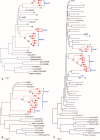Centralized HIV Program Oversight: An Investigation of a Case Series of New HIV Infections among US Army Soldiers, 2012 to 2013
- PMID: 26579822
- PMCID: PMC4652831
- DOI: 10.1097/MD.0000000000002093
Centralized HIV Program Oversight: An Investigation of a Case Series of New HIV Infections among US Army Soldiers, 2012 to 2013
Erratum in
-
Erratum: Centralized HIV Program Oversight: An Investigation of a Case Series of New HIV Infections among US Army Soldiers, 2012 to 2013: Erratum.Medicine (Baltimore). 2016 Jan 22;95(3):e8498. doi: 10.1097/01.md.0000479950.17284.98. eCollection 2016 Jan. Medicine (Baltimore). 2016. PMID: 31265608 Free PMC article.
Abstract
Centralized HIV program oversight and repeal of the Department of Defense policy "Don't Ask Don't Tell" permitted characterization of HIV transmission among soldiers assigned to a large US Army base continental United States from 2012 to 2013. An investigation of a greater than expected number of new HIV infections among soldiers was initiated to characterize transmission and identify opportunities to disrupt transmission and deliver services.All soldiers who were assigned to the base at the time of their first positive HIV test and who had their first positive HIV test in 2012 or in the first 6 months of 2013 and who had a clinical genotype available for analysis were eligible for inclusion in the investigation.All patients (n = 19) were men; most were black (52%) and less than 30 years old (64%). Fifteen of the 19 patients participated in in-depth interviews. Eighty percent were men who have sex with men who reported multiple sex partners having met through social and electronic networks. All were subtype B infections. Significant knowledge gaps and barriers to accessing testing and care in the military healthcare system were identified. Most (58%) belonged to transmission networks involving other soldiers.This investigation represents an important step forward in on-going efforts to develop a comprehensive understanding of transmission networks in the Army that can inform delivery of best practices combination prevention services. The Army is developing plans to directly engage individuals in key affected populations most at risk for HIV infection to identify and address unmet needs and expand delivery and uptake of prevention services. Further investigation is underway and will determine whether these findings are generalizable to the Army.
Conflict of interest statement
The authors have no conflicts of interest to disclose.
Figures

References
-
- Singer DE, Bautista CT, O’Connell RJ, et al. HIV infection among U.S. Army and Air Force military personnel: sociodemographic and genotyping analysis. AIDS Res Hum Retroviruses 2010; 26:889–894. - PubMed
-
- Department of the Army. Identification, surveillance, and administration of personnel infected with human immunodeficiency virus (HIV). Washington, DC: AR 600-110 22; 2014.
-
- Armed Forces Health Surveillance Branch.. Update: routine screening for antibodies to human immunodeficiency virus, Civilian Applicants for U.S. Military Service and U.S. Armed Forces, Active and Reserve Components, January 2009–June, 2014. MSMR 2014; 21:16–22. - PubMed
-
- Centers for Disease Control and Prevention. HIV Surveillance Report, 2012; vol. 24. http://www.cdc.gov/hiv/library/reports/surveillance/. Published November 2014 Accessed [February 10,2015].
-
- Undersecretary of Defense Clifford L. Stanley. Department of Defense, Personnel and Readiness. Memorandum. Repeal of ‘Don’t Ask Don’t Tell’. September 20, 2011.
Publication types
MeSH terms
LinkOut - more resources
Full Text Sources
Medical
Miscellaneous

